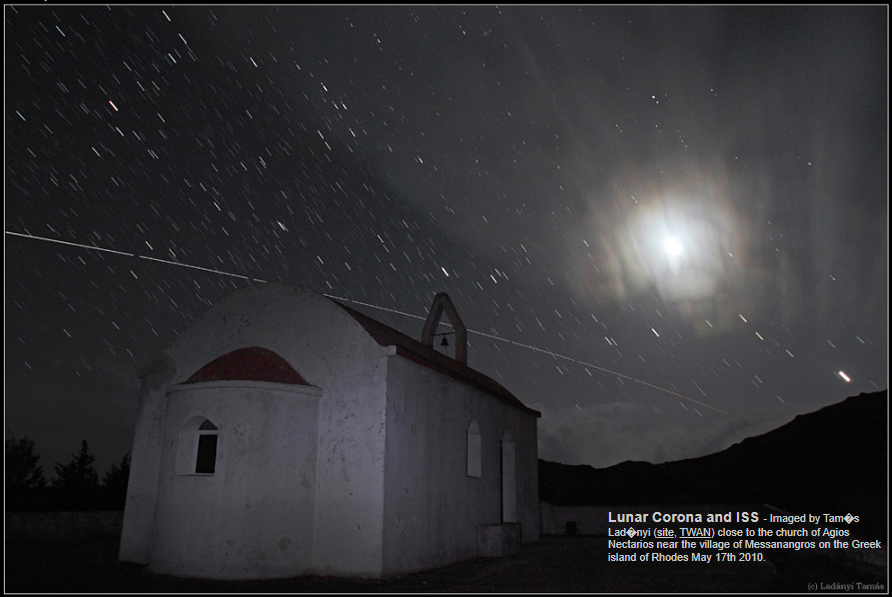ISS & Corona
The Intriguing Phenomenon of ISS & Corona
Have you ever looked up at the night sky and noticed a mesmerizing halo of light encircling the moon or the sun? This captivating phenomenon is known as a corona. While coronas can be seen around various celestial bodies, such as the moon, the sun, or even streetlights, there is one particular occurrence that adds an extra layer of fascination: the ISS & Corona.
When it comes to atmospheric optics effects like halos, rainbows, coronae, and glories, they are all created by the scattering of light by numerous particles in the atmosphere. In the case of a corona, the misty pastel-hued circle around the moon or the sun is formed by water droplets in thin clouds. As waves strike these droplets, they scatter primarily at the droplet's surface. The outgoing scattered waves then combine constructively or destructively, resulting in a fringed diffraction pattern - a corona.
To fully grasp the complexity of this phenomenon, it's essential to understand that the pattern we see in the sky is not solely produced by a single droplet, but rather by millions of individual droplet contributions. Each droplet diffracts light in various directions, some towards our eyes and some away. Consequently, as we observe a corona, we are witnessing the collective effect of countless droplets interacting with light.
Now, let's delve into the peculiar connection between the International Space Station (ISS) and coronas. As the ISS orbits the Earth at an altitude of approximately 408 kilometers (253 miles), it occasionally passes through thin layers of clouds. During these moments, observers on the ground might notice a fading track of red light as the ISS traverses the sky.
But why does this happen? The answer lies in the same principle that creates coronas around celestial bodies. When the ISS passes through a cloud layer, the light from the Sun or the Moon is diffracted by the water droplets in the clouds. This diffraction causes the light to scatter and creates a corona-like effect around the ISS.
However, unlike the coronas we see around the moon or the sun, the ISS track appears red in color. This intriguing phenomenon occurs due to the nature of light scattering. When light passes through a medium, such as Earth's atmosphere or a cloud, shorter wavelengths, like blue and green, are scattered more than longer wavelengths, such as red. As a result, the predominant color observed in the ISS track is red.
It's important to note that the intensity and color of the ISS track can vary depending on factors such as the thickness and composition of the cloud layer, as well as the angle at which the sunlight interacts with the droplets. These variables contribute to the unique and ever-changing spectacle witnessed by those lucky enough to catch a glimpse of the ISS & Corona.
In conclusion, the ISS & Corona phenomenon showcases the captivating interplay between light and atmospheric particles. As the International Space Station orbits our planet, it occasionally passes through thin cloud layers, resulting in a fading track of red light reminiscent of a corona. This mesmerizing display serves as a reminder of the intricate beauty found within our atmosphere and the countless wonders that await us when we cast our eyes towards the sky.

Lunar Corona and ISS - Imaged by Tam�s Lad�nyi (site, TWAN) close to the church of Agios Nectarios near the village of Messanangros on the Greek island of Rhodes May 17th 2010.

Diffraction by a single cloud particle to produce a corona pattern on a screen.
The misty pastel hued corona circling the moon is produced by water droplets in the thin cloud.
Waves striking each droplet are scattered, primarily at its surface. The outgoing scattered waves combine constructively or destructively to form a fringed diffraction pattern, a corona.
The pattern we see in the sky is from millions of individual droplet contributions. In any one direction some droplets are diffracting light (or not) towards the eye.
In general, atmospheric optics effects (halos, rainbows, coronae and glories) are produced by immense numbers of individual scattering particles. The pattern that a single particle would produce if projected on a screen is the same as that seen in the opposite direction in the sky from millions and millions of particles.
Why does the ISS track fade to red?
Note: this article has been automatically converted from the old site and may not appear as intended. You can find the original article here.
Reference Atmospheric Optics
If you use any of the definitions, information, or data presented on Atmospheric Optics, please copy the link or reference below to properly credit us as the reference source. Thank you!
-
<a href="https://atoptics.co.uk/blog/iss-corona/">ISS & Corona</a>
-
"ISS & Corona". Atmospheric Optics. Accessed on November 8, 2024. https://atoptics.co.uk/blog/iss-corona/.
-
"ISS & Corona". Atmospheric Optics, https://atoptics.co.uk/blog/iss-corona/. Accessed 8 November, 2024
-
ISS & Corona. Atmospheric Optics. Retrieved from https://atoptics.co.uk/blog/iss-corona/.